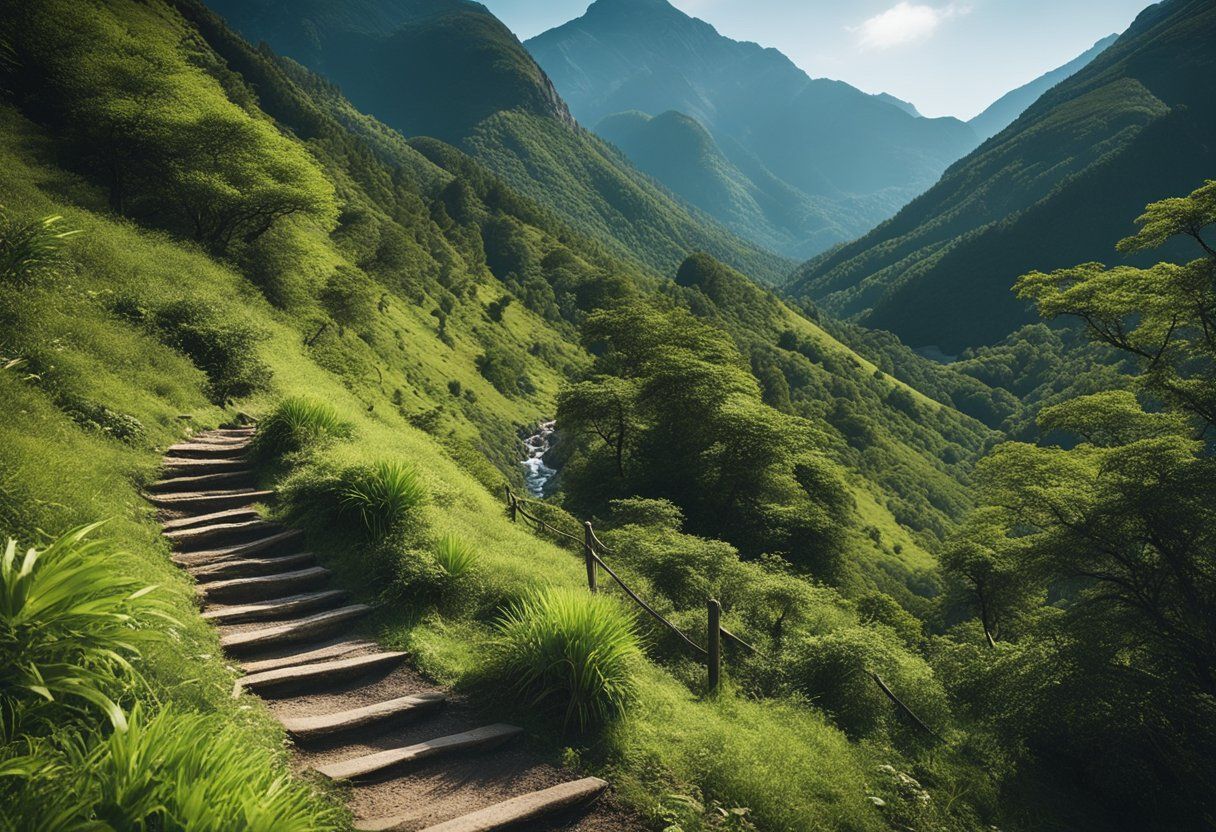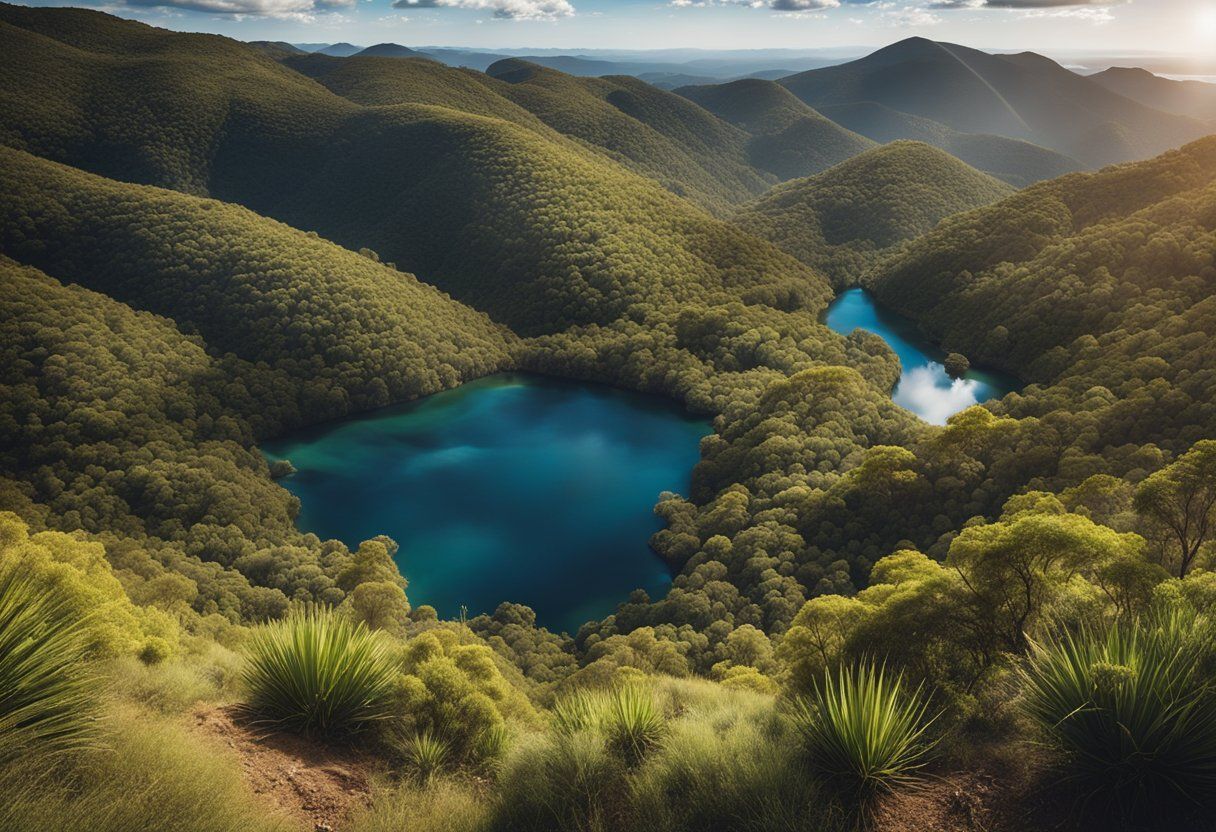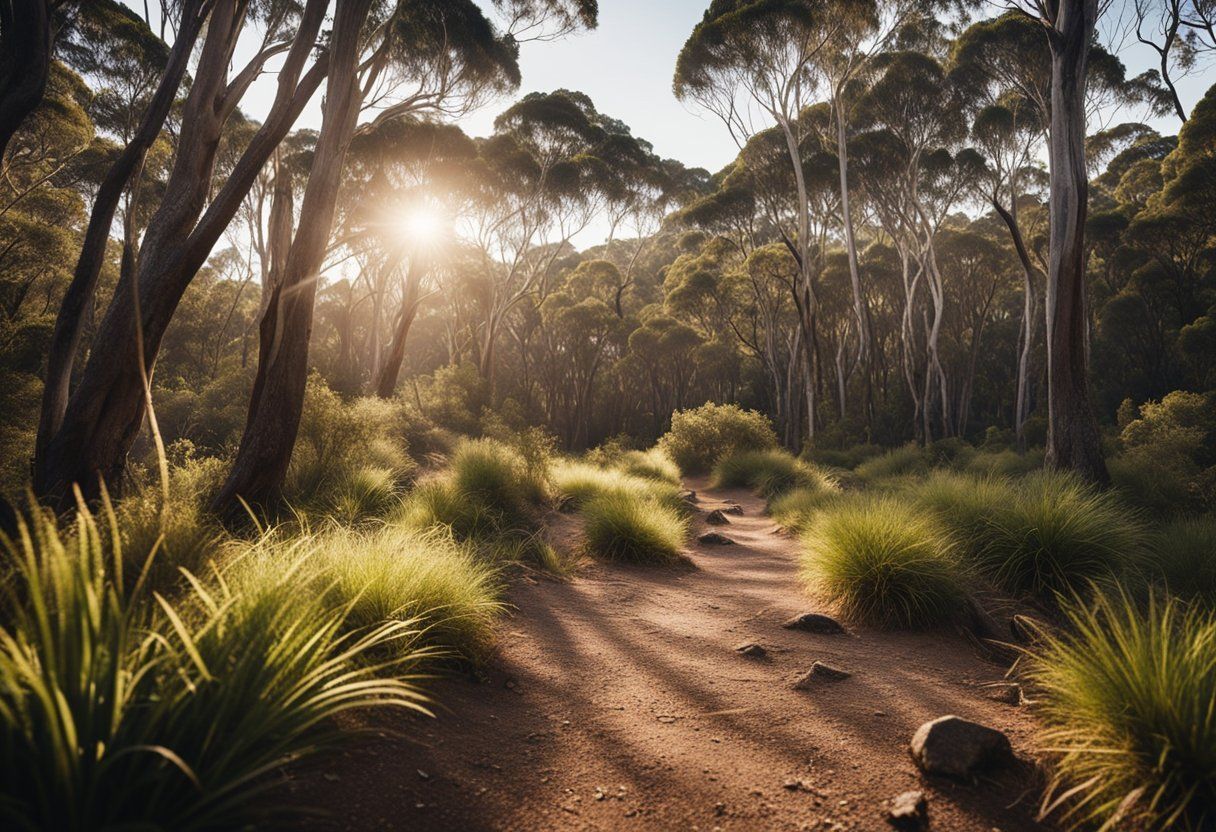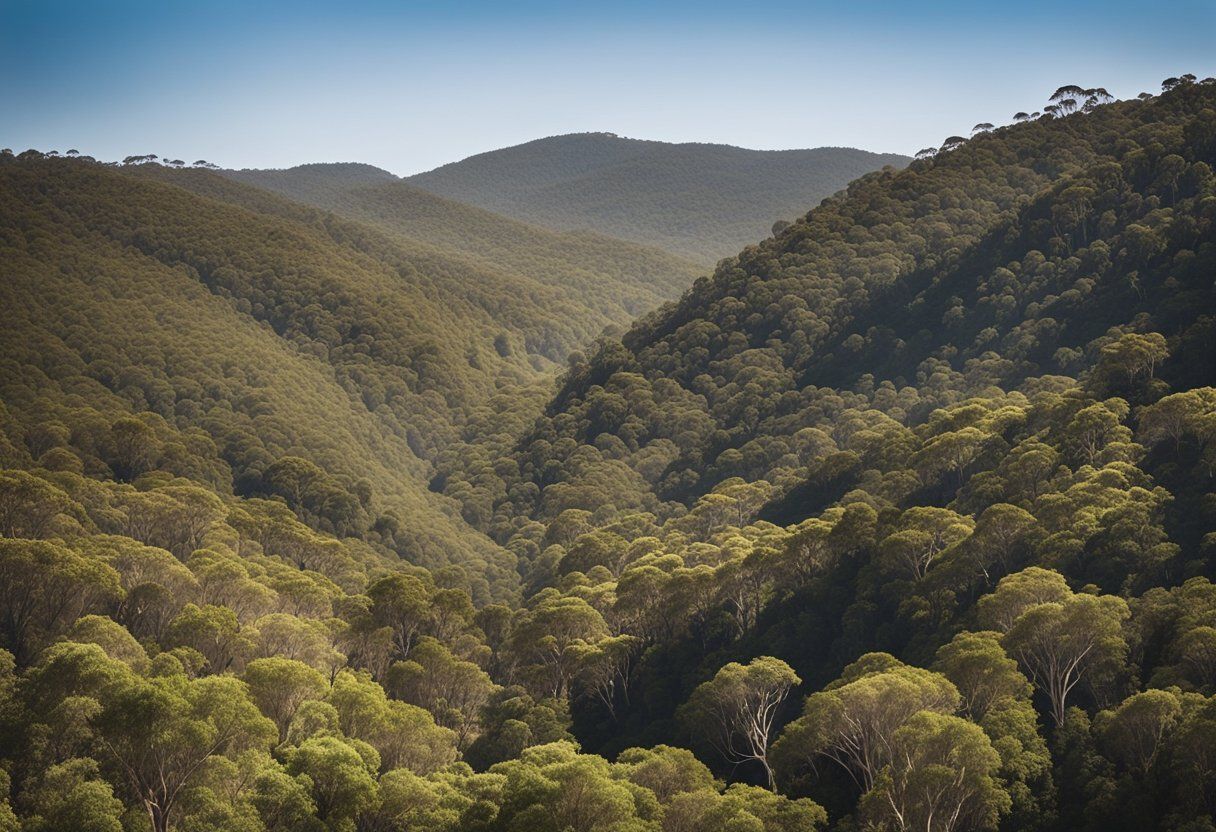To share
Exploring Australia’s vast landscapes on foot offers an incredible adventure through diverse terrains, from coastal paths to rugged mountains. Multi-day hikes in Australia provide a unique way to engage with the country's natural beauty and offer varying levels of challenge to suit different types of adventurers. Whether walking through ancient rainforests or alongside sun-kissed beaches, these trails unveil the heart of Australia.

For those seeking an immersive experience, Australia's trails also offer a deep connection with nature. Wander through protected national parks and witness breathtaking vistas that few get to see. Walks like the Larapinta Trail in the Northern Territory provide both challenge and reward with each step.
Australia offers options for self-guided journeys or guided hikes that provide additional insights. Consider planning logistics, understanding the environment, and evaluating the benefits of joining a group versus going solo. Both paths promise unforgettable experiences and a strong sense of achievement.
Key Takeaways
- Multi-day hikes in Australia showcase diverse landscapes and experiences.
- Planning includes logistics, accommodation, and understanding trails.
- Options include both self-guided adventures and guided group hikes.
Planning Your Multi-Day Hike

Planning a multi-day hike involves several key steps that ensure a safe and enjoyable experience on Australia's diverse trails. Begin with selecting a suitable trail, pack carefully, understand safety measures, and comply with regulations.
Selecting the Right Trail
Selecting the right trail depends on the hiker's experience, fitness level, and desired scenery. Australia offers a range of options, like the challenging Australian Alps Walking Track, which spans through mountainous terrain, or the coastal Cape to Cape Track for ocean views. Consider trail length, elevation, and weather conditions. Explore popular national parks like the scenic trails in Queensland's hinterland or Tasmania’s wild landscapes. Check trail difficulty and expected duration through guidebooks or online resources, and make sure the selected trail aligns with the group’s skill level and interests.
Packing Essentials
Packing for a multi-day hike requires careful planning. Essentials include a sturdy backpack, tent, sleeping bag, and mat for comfortable overnight stays. Bring clothing suitable for the weather, focusing on layers and waterproof items. Food is crucial; opt for lightweight, high-energy items like dried fruits, nuts, and energy bars. Include a reliable water filter or purification tablets for safe drinking water access. A map, compass, and portable GPS ensure navigation across varying terrains. Don’t forget a basic first aid kit, sunscreen, insect repellent, and essential tools like a multi-tool or Swiss army knife. Distribute weight evenly to maintain balance and comfort while hiking.
Safety and Navigation
Safety and navigation are paramount in multi-day hikes. Start by informing someone of the hiking itinerary and expected return date. Equip with a navigation kit: map, compass, and updated GPS device. Many trails, especially in remote areas, may not have reliable mobile reception. Signposts and markers on Australian trails can vary in frequency, demanding solid navigation skills. Understanding weather changes is also important. Always monitor forecasts and be prepared for sudden shifts. During Bushwalks, practice environmentally responsible hiking by following Leave No Trace principles to preserve nature. Conserving local ecosystems ensures trails remain beautiful for future hikers.
Permits and Regulations
Before embarking, check if permits are required for the chosen trail. Places like national parks or protected areas often need hiking permits to regulate foot traffic and conserve wildlife habitats. The Larapinta Trail in the Northern Territory, for instance, may require special permissions. Familiarise with specific park regulations and staying overnight rules. Camp only in designated areas to minimise environmental impact. Fire restrictions in some regions, especially during dry seasons, require hikers to use portable stoves for cooking instead of open flames. Respect all park guidelines to ensure a safe and responsible hiking adventure.
Iconic Multi-Day Hikes by Region

Australia offers an incredible array of multi-day hikes, each showcasing unique landscapes and cultural heritage. From the red sands of the Northern Territory to the lush rainforests of Queensland, these trails invite hikers to explore the diverse beauty of the continent.
Northern Territory - Larapinta Trail
The Larapinta Trail spans 223 kilometres through the rugged beauty of the Northern Territory. This trail offers a challenging adventure across the West MacDonnell Ranges. Hikers traverse dramatic ridges, explore red rock gorges, and encounter both ancient indigenous sites and unique wildlife.
Highlights include Simpson’s Gap and Ormiston Gorge. The trail is divided into 12 sections, allowing walkers to tackle specific parts or complete the entire trek over several days. It's essential to prepare well, as the remote conditions can be challenging, especially in hotter months. This trail is best enjoyed between April and September when the weather is cooler.
Tasmania - Overland Track
Tasmania’s Overland Track is a premier 65-kilometre trek located in the Cradle Mountain-Lake St Clair National Park. The track offers a diverse range of ecosystems, from dense rainforests to alpine meadows. It takes hikers through some of Tasmania's most stunning natural scenery, including iconic Cradle Mountain and Lake St Clair, Australia's deepest lake.
Each section of the track offers unique views, with the opportunity to spot diverse wildlife like wallabies and wombats. The trek usually takes six days, and hikers are advised to book their journey well in advance, especially during summer months when it is most popular.
Victoria - Australian Alps Walking Track
The Australian Alps Walking Track runs 655 kilometres from Victoria to New South Wales, meandering through the high country of the Australian Alps. It’s a long and challenging journey that offers breathtaking views of snow-capped peaks and vast wilderness areas.
The trail passes through several national parks, including the Alpine National Park, providing opportunities to spot native wildlife and experience alpine flora. Hikers need to be well-prepared for varying weather conditions and extended periods of isolation. This track is an adventurous choice for experienced bushwalkers seeking a blend of tranquillity and challenge.
Western Australia - Bibbulmun Track
The Bibbulmun Track in Western Australia stretches over 1,000 kilometres from Kalamunda, near Perth, to Albany on the south coast. Known for its diverse and changing landscapes, the track includes towering forests, expansive beaches, and stunning coastal cliffs.
The track is divided into multiple sections, with ample campsites along the way, making it accessible for both short and extended treks. Its well-maintained paths are marked by yellow triangle markers featuring the Waugal symbol, a nod to Aboriginal heritage. This long-distance walk is ideal for those wanting to experience a mix of natural beauty and solitude.
South Australia - Heysen Trail
South Australia's Heysen Trail covers 1,200 kilometres from Cape Jervis on the Fleurieu Peninsula to the Parachilna Gorge in the Flinders Ranges. The trail takes hikers through varied terrains, including ocean cliffs, vineyards, and the rugged landscapes of the Flinders Ranges.
Walkers can experience rich cultural history and stunning natural beauty along this extensive path. The Heysen Trail is seasonal, closed during the summer due to fire danger, and best hiked in cooler months between April and November. Its impressive biodiversity and dramatic scenery make it a trail to remember.
Queensland - Thorsborne Trail
The Thorsborne Trail on Hinchinbrook Island in Queensland is a 32-kilometre trek through one of Australia's most pristine national parks. This track offers a chance to explore rainforests, mangroves, and beaches, surrounded by the awe-inspiring beauty of the tropical landscape.
The trail is designed for a self-sufficient, two to four-day adventure, with limited facilities along the way. Hikers need to carry all their supplies, including water, and must plan carefully as the trail is isolated and permits are required. It's an excellent choice for those seeking a slice of untouched wilderness.
New South Wales - Blue Mountains Tracks
The Blue Mountains Tracks in New South Wales offer a range of multi-day hiking options through lush rainforests, ancient landscapes, and breathtaking rock formations. The area is part of the UNESCO World Heritage-listed Greater Blue Mountains Area.
Popular routes include the Six Foot Track, a historic 45-kilometre trail from Katoomba to Jenolan Caves, and multi-day circuits through the Grose Valley. These tracks showcase dense eucalyptus forests, sandstone cliffs, and the chance to see native wildlife like kangaroos and lyrebirds. They provide stunning vistas and are accessible for hikers with varied skill levels.
Experience Themes in Australian Hikes

Australian multi-day hikes offer diverse themes that suit different interests. From wildlife encounters to coastal views and cultural heritage, these hikes provide a rich tapestry of experiences, engaging hikers with both nature and history.
Wilderness and Wildlife
Australia's expansive wilderness areas invite hikers to immerse themselves in untamed nature. Trails like the Larapinta Trail in the Northern Territory showcase rugged landscapes. Hikers might spot kangaroos, wallabies, and a variety of bird species.
The emphasis on conservation ensures these areas remain pristine. Kakadu National Park, for example, highlights the importance of preserving unique ecosystems while offering the chance to witness flora and fauna in their unspoiled environments. These trails not only offer physical challenges but also moments of reflection.
Ancient Rainforests and Scenic Rims
Ancient rainforests offer a glimpse into Australia's natural history. The Scenic Rim Trail in Queensland leads hikers through lush landscapes rich in biodiversity. Towering trees and vibrant plant life create a serene atmosphere, drawing visitors into a world far removed from urban life.
These ecosystems are home to myriad species, some found nowhere else on Earth. As one walks through the dense foliage, they experience the tranquillity and ancient rhythms of the forest. This theme highlights the vital role rainforests play in global biodiversity and provides a soulful journey for nature enthusiasts.
Beach Tracks and Coastal Walks
Australia's coastline offers some stunning hiking experiences. The Cape to Cape Track in Western Australia spans over 100 kilometres, treating hikers to dramatic cliffs, sandy beaches, and sweeping ocean vistas. The contrast between land and sea creates a dynamic landscape that's constantly shifting with the tides.
Similarly, the Great Ocean Walk showcases the iconic Twelve Apostles. This trail is ideal for those who love the sound of waves and the scent of salt air. Coastal walks allow hikers to connect with the natural world while enjoying physical challenges and remarkable views.
Historical and Cultural Insights
Australian hikes don't just offer natural beauty—they are also rich in cultural and historical significance. Trails like the Bicentennial National Trail weave through historical routes that played key roles in the nation's development. These paths offer insights into Indigenous cultures and the stories of pioneers.
In Kakadu National Park, hikers can explore ancient rock art sites that tell stories of the region's traditional owners. This theme allows walkers to delve into Australia's rich tapestry of human history, adding depth and understanding to the hiking experience. Cultural encounters on the trail enrich the journey, offering perspectives that are both educational and profound.
Accommodation and Amenities

Exploring Australia's multi-day hikes requires planning for accommodation and amenities. Hikers have options ranging from camping sites to luxury lodges. Hospitality services offer convenient resting spots, while some trails provide gourmet meal experiences.
Camping and Shelter Options
Many Australian trails offer designated camping areas equipped with basic amenities such as toilets and water access. For example, the Larapinta Trail includes several campsites along its path, providing shelter and rest spots. Some sites may require reservations, especially during peak seasons.
Hikers can choose between using their own gear or staying in shelters that might be available on certain trails. Shelters can vary from simple huts to eco-friendly lodges, providing a comfortable resting place after a long day of hiking.
Hospitality Services
On some trails, hikers can access hospitality services offering more comfortable accommodations. Options like cabins or lodges can be found along paths such as the Great Ocean Walk. These provide a warm bed and hot meals, offering a respite from the day’s trek.
Some services even offer transport for backpacks and gear, allowing hikers to enjoy their walk without the extra weight. Booking in advance is often necessary to secure a spot, especially in popular areas.
Gourmet Meals along the Trail
Certain Australian hikes are known for providing gourmet meal options, enhancing the trekking experience. Trails like the Twelve Apostles Lodge Walk offer guided tours with meals prepared by chefs, using local ingredients.
These meals range from breakfast packs to full-course dinners, often paired with regional wines. The opportunity to savour high-quality meals adds a touch of luxury to the rugged adventure, making these hikes appealing to those seeking a unique outdoor experience.
Environment and Conservation

Multi-day hikes in Australia offer stunning encounters with diverse ecosystems. It's vital to follow responsible hiking practices and support conservation efforts to protect these unique landscapes.
Responsible Hiking Practices
Hikers should prioritise minimal impact on the environment. This includes staying on marked trails to protect sensitive flora and fauna. Carrying all rubbish out and avoiding the disturbance of natural habitats is essential. Hikers should be mindful of campfire regulations and use fuel stoves where possible to prevent wildfires.
Respecting wildlife by maintaining a safe distance and not feeding animals is crucial. Additionally, hikers should ensure their gear is cleaned to prevent the spread of invasive species. By practicing these guidelines, the natural beauty and ecological balance of Australia’s hiking trails are protected for future generations.
Supporting National Parks and Reserves
National parks and reserves play a critical role in conserving Australia's natural treasures. Supporting these protected areas can be achieved through park entry fees, which fund maintenance and conservation programmes. Hikers can also volunteer in conservation projects or join local bush regeneration groups to directly contribute to habitat restoration.
Donations to organisations dedicated to these efforts help sustain vital projects for endangered species and ecosystems. Staying informed about conservation issues and advocating for policies that benefit natural areas is another way to contribute. By actively supporting these initiatives, individuals can ensure the preservation of Australia's magnificent wilderness areas while enjoying their adventures on the trails.
Challenges and Rewards

Exploring Australia's multi-day hikes requires commitment and preparation. Each hike demands physical and mental resilience, but they also offer priceless rewards like breathtaking views and a sense of accomplishment.
Physical and Mental Preparation
Embarking on a multi-day hike in Australia, such as along the Six Foot Track, requires thorough physical preparation. Hikers need to build endurance through regular exercise, combining cardio workouts with strength training.
Mental preparedness is crucial. Trekkers should anticipate challenges and remain positive, even when navigating tough terrain. Adequate planning involves understanding the trail's difficulty, pack essentials, and consider weather conditions, particularly in remote wilderness areas.
The Rewards of Completing a Multi-Day Hike
The joy of cresting a summit or reaching a secluded beach often outweighs the challenges faced during the hike. Completing trails like the Cape to Cape Track offers stunning coastal views and diverse wildlife.
Hikers experience a unique connection with nature and often gain insight into the importance of conservation. The sense of achievement is profound, leaving many feeling rejuvenated and inspired beyond the trail. The time spent trekking through Australia's wilderness areas can foster a deeper appreciation for its natural beauty and heritage.
Joining a Guided Group versus Self-Guided

For multi-day hikes in Australia, choosing between a guided group and a self-guided trek involves considering factors like comfort, support, and independence. Guided hikes offer structured support and expert knowledge, while self-guided hikes provide flexibility and personal exploration experiences.
Benefits of Guided Hikes
Guided hikes in Australia ensure safety and ease for trekkers, providing immense value. The guides offer local insights and knowledge about the Great Walks of Australia. They assist with navigation, letting hikers focus on enjoying the scenery.
Groups often have pre-arranged lodgings and meals, reducing logistical concerns. This is especially helpful on popular routes like the Great Ocean Walk. Experienced guides also improve the journey with stories about the landscape, enhancing the experience.
For beginners or those unfamiliar with trekking, a guided option offers added security. Walking with trained professionals increases confidence, knowing someone can handle emergencies. This support is crucial for both first-timers and seasoned hikers looking for a relaxed venture.
Self-Guided Journey: What to Know
Opting for a self-guided journey gives adventurers flexibility and independence. Hikers can set their own pace, take breaks as needed, and tailor their experience to personal preferences. This is perfect for those who enjoy exploring at their own speed and making spontaneous decisions, especially on trails like the Freycinet Peninsula Circuit.
Preparation for a self-guided hike involves more logistics. Trekkers need to map their routes, arrange accommodations, and plan meals. Essential skills include navigation and a basic understanding of the area’s flora and fauna.
Self-guided hikes often appeal to experienced adventurers seeking solitude and personal challenges. This route offers a sense of accomplishment as trekkers rely on themselves throughout the journey, leading to a rewarding hiking experience.
Frequently Asked Questions

Australia offers a range of multi-day hikes, from challenging treks for seasoned adventurers to beginner-friendly trails. Some journeys provide comfortable accommodation options, while others require self-sufficiency. Here are some commonly asked questions regarding these treks.
What are the best multi-day treks in Victoria for experienced hikers?
Victoria boasts some impressive multi-day hikes like the Great Ocean Walk. It stretches along a rugged coastline, offering stunning views and challenging terrain for experienced hikers. The Victorian Alpine Walking Track is another demanding option that runs through the high country.
Which multi-day treks in Australia offer comfortable accommodation?
For those seeking comfort, the Bay of Fires Lodge Walk in Tasmania provides eco-lodge accommodation. The Scenic Rim Trail in Queensland also offers luxurious lodgings, making it easier to experience the beauty of the Australian wilderness.
Can you recommend any beginner-friendly multi-day hikes in Australia?
Beginners might enjoy the Overland Track in Tasmania, which offers guided tours. The Cape to Cape Track in Western Australia is another good starting point with its well-marked paths and stunning coastal views. Both provide manageable distances for those new to multi-day hiking.
Which are the most challenging multi-day hikes across Australia?
The Heysen Trail in South Australia, stretching over 1,200 kilometres, is one of the longest and most demanding trails. Similarly, the Larapinta Trail in the Northern Territory offers rugged landscapes and requires excellent planning and endurance.
What are Australia's Great Walks and what do they entail?
Australia's Great Walks include iconic trails like the Larapinta Trail and Overland Track. These treks showcase some of the most remarkable natural landscapes with challenges varying from moderate to extreme. They require good preparation but reward hikers with breathtaking scenery and a sense of achievement.
How should one prepare for their first multi-day hike in Australia?
Preparation is key. Hikers should focus on fitness, planning their route, and packing essential gear. Training with shorter hikes and carrying a loaded backpack helps condition the body. Researching the specific trail conditions and weather is crucial to ensure a safe and enjoyable multi-day hike.




